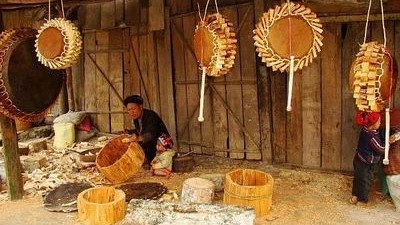Vietnam has added 11 more cultural icons to the list of national intangible cultural heritage, according to the Ministry of Culture, Sports and Tourism.

The drum making of Dao Do ethnic people in the northwest province of Lao Cai’s Sa Pa district.
They are a festival in Chu Xa Village at Van Duc Commune, Hanoi’s Gia Lam District; the “gau tao” festival of H’Mong ethnic people in the districts of Phong Tho, Sin Ho and Tam Duong in the northern mountainous province of Lai Chau; the Dai Bi Pagoda festival at Nam Giang Town, Nam Truc District, in the northern province of Nam Dinh; the “Cap sac” ritual of Dao Quan Chet ethnic people at Huoi So Commune, in the northwest province of Dien Bien’s Tua Chua District; the Linh Quang Pagoda festival at Phuong Dinh Commune, in the northern province of Nam Dinh’s Truc Ninh District; the “Cap sac” ritual of Dao Tien ethnic people at Xuan Son Commune, in the northern province of Phu Tho’s Tan Son District; the “goi au” (Lung ta) ritual of the Thai Trang ethnic group in Quynh Nhai District, in the northwestern province of Son La; the Tra On Temple festival at Thien My Commune, in the Mekong delta province of Vinh Long’s Tra On District; and the Nguyen Tieu (Mid-First Lunar Month) festival of the Hoa ethnic people in Ho Chi Minh City.
In addition, the drum making of Dao Do ethnic people in Sa Pa district, in the northwest province of Lao Cai, and the art of pattern making on costumes of H’Mong Hoa ethnic people in Moc Chau District, Son La Province, were named as national intangible cultural heritages.
These recognised intangible cultural heritages are divided into the four categories of traditional handicrafts, traditional festivals, social practices and beliefs, and folklore knowledge.
The ministry assigned the authorities at all levels in localities where intangible cultural heritages are located to be responsible for the management of the heritages within the scope of their duties and in accordance with the law and regulations on cultural heritages.
Source: NDO
VNQD